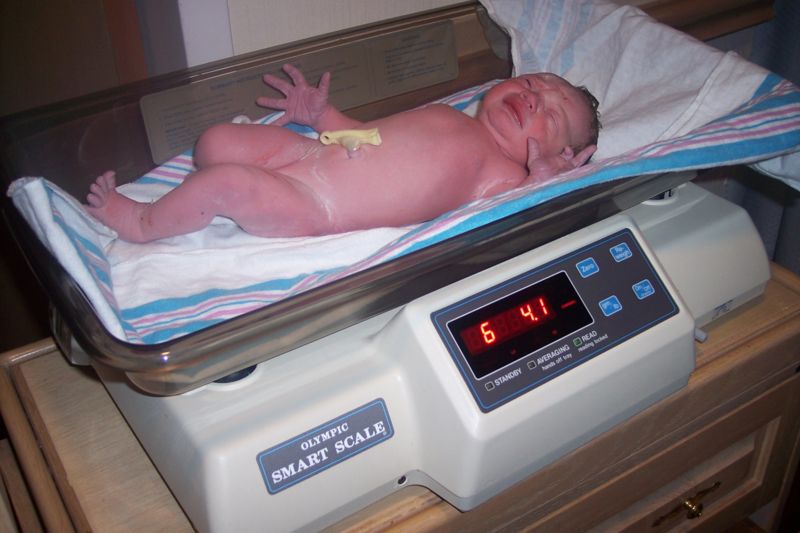Birth mass

|
WikiDoc Resources for Birth mass |
|
Articles |
|---|
|
Most recent articles on Birth mass |
|
Media |
|
Evidence Based Medicine |
|
Clinical Trials |
|
Ongoing Trials on Birth mass at Clinical Trials.gov Clinical Trials on Birth mass at Google
|
|
Guidelines / Policies / Govt |
|
US National Guidelines Clearinghouse on Birth mass
|
|
Books |
|
News |
|
Commentary |
|
Definitions |
|
Patient Resources / Community |
|
Patient resources on Birth mass Discussion groups on Birth mass Patient Handouts on Birth mass Directions to Hospitals Treating Birth mass Risk calculators and risk factors for Birth mass
|
|
Healthcare Provider Resources |
|
Causes & Risk Factors for Birth mass |
|
Continuing Medical Education (CME) |
|
International |
|
|
|
Business |
|
Experimental / Informatics |
Editor-In-Chief: C. Michael Gibson, M.S., M.D. [1]
Overview
Birth mass is the mass of a baby at its birth. It has direct links with the gestational age at which the child was born and can be estimated during the pregnancy by measuring fundal height. A baby born within the normal range of mass for that gestational age is known as appropriate for gestational age (AGA). Those born above or below that range have often had an unusual rate of development – this often indicates complications with the pregnancy that may affect the baby or its mother. The incidence of birth mass being outside of the AGA is influenced by the parents in numerous ways, including:
- Genetics
- The health of the mother, particularly during the pregnancy
- Environmental factors, including exposure of the mother to secondhand smoke[1], pp. 198–205
- Other factors, like multiple births, where each baby is likely to be outside the AGA, one more so than the other
There have been numerous studies that have attempted, with varying degrees of success, to show links between birth mass and later-life conditions, including diabetes, obesity, tobacco smoking and intelligence.
Conditions
Associated conditions include:
Influence on adult life
Studies have been conducted to investigate how a person's birth mass can influence aspects of their future life. This includes theorised links with obesity, diabetes and intelligence.
Obesity
A baby born small or large for gestational age (either of the two extremes) is thought to have an increased risk of obesity in later life.[2][3][4]
GH therapy at a certain dose induced catch-up of lean body mass (LBM). However percentage body fat decreased in the GH-treated subjects. Bone mineral density SDS measured by DEXA increased significantly in the GH-treated group compared to the untreated subjects, though there is much debate over whether or not SGA (small for gestational age) is significantly adverse to children to warrant inducing catch-up.[5]
Diabetes
Babies that have a low birth mass are thought to have an increased risk of developing type 2 diabetes in later life.[6][7][8]
Intelligence
Some studies have shown a direct link between an increased birth mass and an increased intelligence quotient.[9][10][11]
See also
References
- ↑ "The Health Consequences of Involuntary Exposure to Tobacco Smoke: A Report of the Surgeon General". Surgeon General of the United States. 2006-06-27. Retrieved 2009-02-07.
- ↑ "3 stages of childhood may predict obesity risk - Fitness - MSNBC.com". Retrieved 2007-11-28.
- ↑ Singhal A, Wells J, Cole TJ, Fewtrell M, Lucas A (2003). "Programming of lean body mass: a link between birth weight, obesity, and cardiovascular disease?". Am J Clin Nutr. 77 (3): 726–30. PMID 12600868. Unknown parameter
|day=ignored (help); Unknown parameter|month=ignored (help) - ↑ Parsons TJ, Power C, Manor O (2001). "Fetal and early life growth and body mass index from birth to early adulthood in 1958 British cohort: longitudinal study". BMJ. 323 (7325): 1331–5. doi:10.1136/bmj.323.7325.1331. PMC 60670. PMID 11739217. Unknown parameter
|month=ignored (help) - ↑ "GH Treatment Effects on Body Composition in SGA". Growth, Genetics & Hormones. 24 (1). 2008. Unknown parameter
|month=ignored (help) - ↑ "BBC NEWS". Retrieved 2007-11-28. Text " Low birth weight diabetes link " ignored (help); Text " Health " ignored (help)
- ↑ Gillman MW, Rifas-Shiman S, Berkey CS, Field AE, Colditz GA (2003). "Maternal gestational diabetes, birth weight, and adolescent obesity". Pediatrics. 111 (3): e221–6. doi:10.1542/peds.111.3.e221. PMID 12612275. Unknown parameter
|month=ignored (help) - ↑ Rich-Edwards JW, Colditz GA, Stampfer MJ; et al. (1999). "Birthweight and the risk for type 2 diabetes mellitus in adult women". Ann Intern Med. 130 (4 Pt 1): 278–84. PMID 10068385.
- ↑ Matte TD, Bresnahan M, Begg MD, Susser E (2001). "Influence of variation in birth weight within normal range and within sibships on IQ at age 7 years: cohort study". BMJ. 323 (7308): 310–4. doi:10.1136/bmj.323.7308.310. PMC 37317. PMID 11498487. Unknown parameter
|month=ignored (help) - ↑ "The Future of Children - Sub-Sections". Retrieved 2007-11-28.
- ↑ "HEALTH | Intelligence linked to birthweight". BBC News. Retrieved 2007-11-28.
it:Restrizione della crescita intrauterina nl:Geboortegewicht